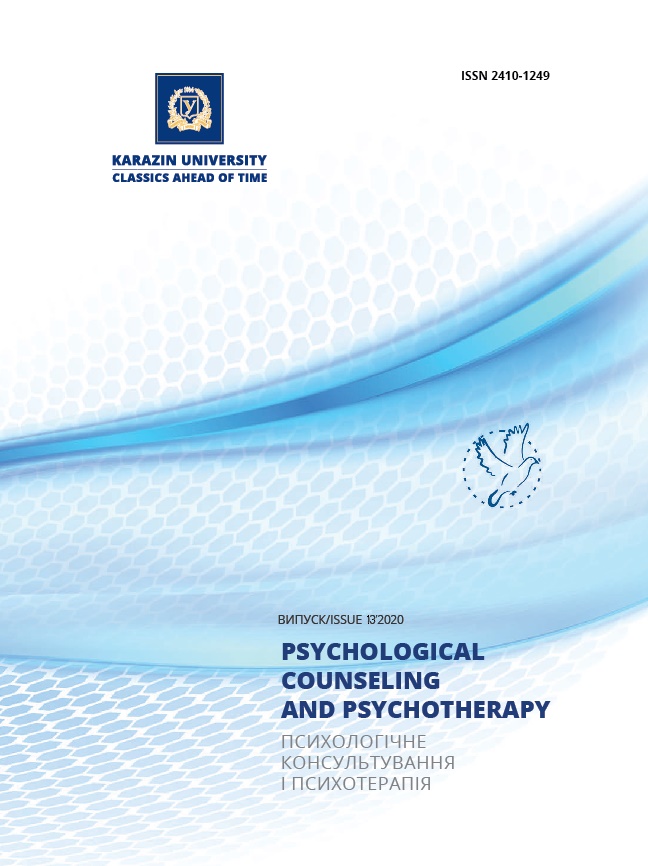Types of Processes in the Client-Centered Therapy
Abstract
The basic theoretical principals of the process theory in client-centered psychotherapy - its stages, the purpose, the basic properties - are discussed in the article. It has been concluded that the process represented by C. Rogers hardly describes the psychotherapy itself; it reflects the process of personal growth. The model of the process motion as liberation from “blocking” emotional experiences is presented. The “block” structure and the model of a “capillary blocked with plaques” as well as clinical examples of “organismic flow” liberation are described. These ‘blocking’ emotions have specific qualities: 1) they are “stuck together” – there are no stand-alone offence, anger, helplessness etc.; they form an integral conglomerate; 2) they are resistant to an influence; 3) they do not disappear completely – they only abate and hide, forming a potential emotionality, which can become actual on the most insignificant occasion; 4) they are somatized,; 5) they are not flowing. “Blocking” emotions have a complex structure: they are based on unconscious primary “blocking” emotional experience (for example, the feeling of second-ratedness) and “secondary” emotional experiences are overlaying on it. Only when the primary components are removed from the structure of “blocking” emotional experience, the conglomerate of “blocking” feelings falls apart into separate emotions, that are ready to move. If any part of psychic becomes “dead”, for example, love and sexuality, then the quality “sort of” emerges in the functionality of an individual. Two clinical examples of work with “blocking” experiences are presented.
Downloads
References
Brodley, B. T. (1987, 7 - 14 August). Client-centered psychotherapy practice. Third International Forum on the Person-Centered Approach meeting. La Jolla, California.
Brodley, B.T. (1990). Client-Centered and Experiential: Two Different Therapies. G., Lietaer, J., Rombauts & R. Van Balen (Eds.). In Client-Centered and Experiential Therapy in the Nineties (pp. 87-108). Belgium: Leuven University Press.
Бурно, М.Е. (2006). Клиническая психотерапия. Москва: Академический проект, Деловая книга.
Джендлин, Ю. (2000). Фокусирование: Новый психотерапевтический метод работы с переживаниями. Москва: Независимая фирма "Класс".
Elliott, R. Emotion-focused therapy In P. Sanders (Ed.). The tribes of the person-centred nation. (pp. 103 – 130). N.Y., 2003.
Ермошин, А.Ф. (1999). Вещи в теле: Психотерапевтический метод работы с ощущениями. Москва: Независимая фирма "Класс".
Hall, C.S., Lindzey, G. (1970). Theories of Personality. New York: Willey and Sons.
Kocharian, A.S. (2019). Process in the client-psychotherapy. Psychological counseling and psychotherapy. ISSU 9, 16-22.
Мак Дугалл, Дж. (2007). Театры тела. Психоаналитический подход к психосоматическим расстройствам. А.В. Россохин (ред.). Москва: Когито-Центр.
Нитшке, В. (1998). Значение сексуальности в трудах Зигмунда Фрейда. В Энциклопедия глубинной психологии. З. Фрейд. Жизнь, работа, наследие. Т.1. (с. 365-406). Москва: Итерна, Менеджмент.
Orlov, A.B. (2010, 4 -10 may). Человеко-центрированный подход как вариант эссециальной психотерапии. Тез. Докладов XI Международного Форума по Человеко-центрированному подходу. Звенигород.
Орлов, А.Б., Ленгле, А., Шумский, В.Б. (2007). Экзистенциальный анализ и клиентоцентрированная психотерапия: сходство и различие. Вопросы психологии, 6, 21-36.
Rennie, D. (1998). Person-Centered Counselling: An experiential approach. London: Sage Publication Inc.
Rice, L.N. (1974). The Evocative Function of the Therapist. In R.F. Wexler & L.N. Rice (Eds.). Innovation in Client-Centered Therapy (pp. 289-311). New York, Wiley.
Rogers, C. (1946). Significant aspects of client-centered therapy. American Psychologist, 1, 415-422.
Rogers, C.R. (1961). On becoming a Person. A Therapist’s View of Psychotherapy. Boston: Houghton Mifflin Company.
Sanford, R. (2005). From Rogers to Gleick and again. In D. Brazier (Ed.). Beyond Carl Rogers. (pp. 253- 273). Constable, London: St. Edmundsbury Press Limited.
Schwartz-Salant N. (1982). Narcissism and Character Transformation: The Psychology of Narcissistic Character. Toronto: University of Toronto Press Incorporated.
Warner M.S. (2013). Person-centred therapy at the difficult edge: a developmentally based model of fragile and dissociated process. In D. Mearns and B. Thorne (Eds.). Person-centred therapy today. (pp. 144-171). London: Sage.
Yong J.E., Klosko J.S., Weishaar M. (2003). Schema Therapy: A Practitioner’s Guide. New York, Guilford Publications.
Yong J.E. (2015). Schema Therapy Inventories and Related Materials. New York, Schema Therapy Institute.
Worsley R. (2009). Process Work in Person-Centred Therapy. London: Palgrave Macmillan.








